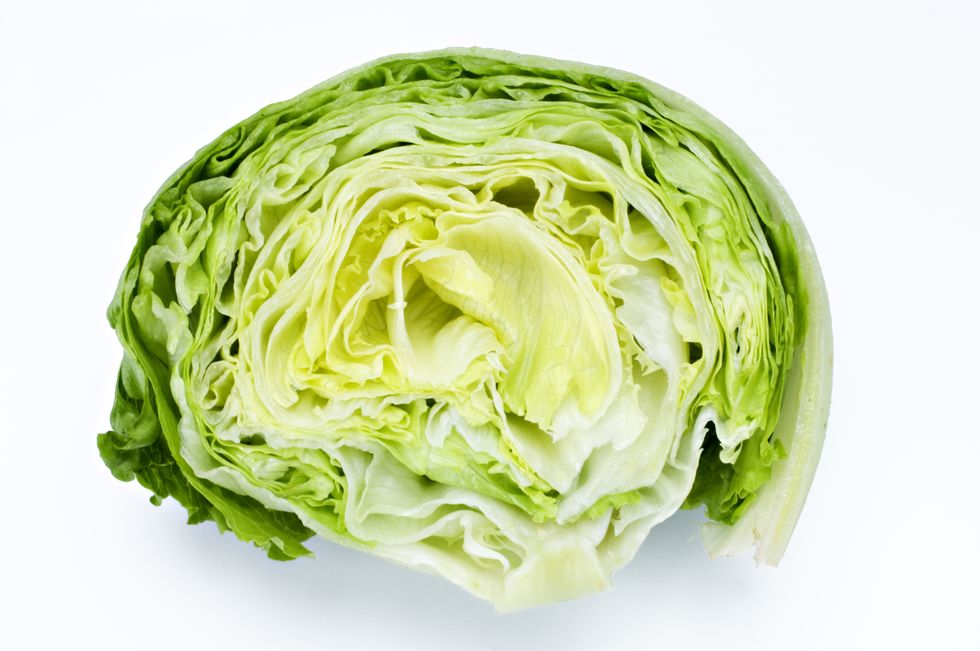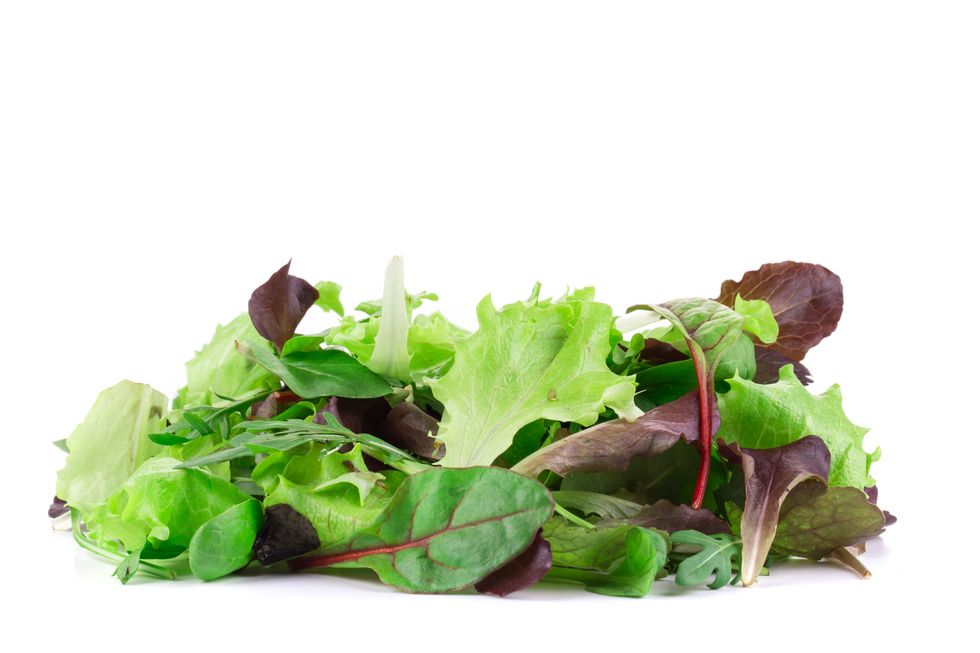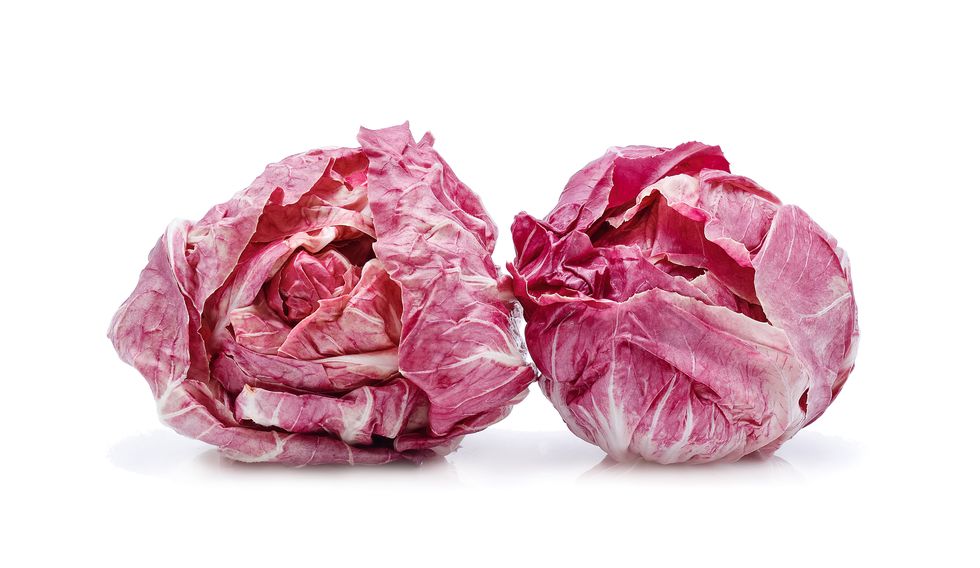Lettuce can get a bad rap. People don't use the term "rabbit food" as a compliment, after all. And if your salad is just a bowl of spinach or romaine, we kind of see where they're coming from.
Don't get it twisted: romaine and spinach are both leafy powerhouses that definitely deserve a spot in your salads. But when you're only using one of those greens, you're missing out on a variety of flavors, colors, and textures that will take your salad from meh to amazing.
Obviously, some signature salads are iconic because of the use of a particular lettuce. A wedge wouldn't be a steakhouse staple without a big hunk of iceberg, and coleslaw (which is 100 percent a salad) needs to include sturdy cabbage. But for when you're straying from the classics and choosing your own salad adventure, consider using these exciting greens.
More From Delish

Arugula
You're probably no stranger to this tender, peppery green. Typically sold pre-washed and in plastic containers or bags, arugula originated in the Mediterranean and is called "rocket" across the pond. Typically you'll find this green picked and sold before the plant has time to mature, as the peppery notes can veer toward bitter the longer it grows.
We love using this green in raw preparations to allow the peppery notes to really shine. It tastes great when dressed lightly with some lemon and Parmesan, mixed into heartier grain salads, and even piled on top of a freshly baked pizza.
Butterhead
Butterhead is a type of lettuce that gets its name from, you guessed it, its smooth and buttery texture. The thin leaves are soft, tender, and perfect for light vinaigrettes. Its mild flavor can work with nearly any type of seasoning and flavor combination, but shouldn't be exposed to heavy dressings, heated, or combined with lots of other vegetables. Otherwise, the leaves can easily wilt and leave you with a sad, limp salad.
Some of the most common types of butterhead lettuces are Boston or Bibb. The names are often used interchangeably despite minor differences in shape and flavor. Because of their delicate nature, they're often grown hydroponically and sold in plastic clamshell containers.
Cabbage
This versatile vegetable is a favorite among Delish editors for multiple reasons. First, it is sturdy enough to cook into hearty dinners like cabbage schnitzel or cabbage parmesan. It also adds lots of texture when served raw, like in our fresh and herbaceous crunch salad. And, most importantly, it's cheap.
Don't feel boxed in with just one variety of cabbage, either. We love the smooth, almost waxy texture of plain green cabbage and the bright hues of red (or is it purple?) cabbage. But Napa cabbage also offers a delightful tenderness and the bumpy textured Savoy variety makes salads extra fun to eat.
Endive
Endives technically aren't a lettuce; they're actually considered a chicory. What distinguishes vegetables in this category are their bitter notes. If you think of bitter as a bad thing, we strongly urge you to think otherwise.
Especially combined with mild flavored greens, endive's delicate bitterness and crisp texture offer a unique complexity to your salads. Also, since each adorable leaf can stand up on its own, it's also fun to place ingredients inside and eat it like a lettuce cup.
Frisée
Frisée is also technically a type of endive. But this variety is so special that it deserves it own category. Maybe you've bought a bag of mixed greens at the grocery store and found a piece of ruffly, stringy frisée among the other lettuces. But we think this lightly bitter green deserves more of a spotlight in your salads.
The word frisée means curly in French, and you can see why it earned the name by looking at its, well, frizzy appearance. It strikes the ideal balance between tender and substantial, which makes it perfect for salads with boiled eggs, bacon bits, and creamy dressings.
Iceberg
Iceberg is the lettuce everyone loves to hate. But we have a soft spot for this crisp, refreshing green. Let's be real: if we're making a crispy, greasy smash burger with American cheese, we're not using some frilly, expensive lettuce. Whether served in a massive wedge or cut into "shrettuce," iceberg adds texture without being too tough.
Kale
From humble beginnings as inedible decorations on buffet lines, kale has had the biggest glow-up of any lettuce around. After becoming the hottest new superfood, it's now a fixture at any grocery store or build-your-own-salad chain. You can find both curly and the flat Lacinato variety at affordable price points.
While nutritious and hearty, it requires some extra TLC before it becomes a delicious base for a salad. First, you need to ensure that you remove the leaves from the fibrous stem. And when serving raw, it's advised that you give the greens some time to soak in the vinaigrette and become more tender before eating.
Little Gem
A fixture on fancy restaurant menus for decades, little gem lettuce gets its name for its diminutive size. Think of this green as if romaine and butter lettuce had a newborn baby. It has all of the mild sweetness of butter lettuce with the crisp crunch of romaine.
What makes this salad green special is that you barely have to break it apart before serving. Many restaurants simply slice it in half, drizzle on some dressing, and send it out. While a bit pricey for most home cooks to use every day, it's great for special occasions.
Loose Leaf
Loose leaf is a category of lettuce that is named after the way the leaves cluster. As opposed to greens like romaine, where the leaves stay close to the heart, loose leaf lettuce flutters out with plenty of space between each leaf. It's also one of the most widely available types of lettuce—and the most affordable.
Both green leaf and red leaf lettuce fall in this category and are great in salads, but their generally light, soft texture means they often can get wet and limp after hanging out in dressing for too long.
Mesclun
Mesclun, also known as spring mix, is a combination of young lettuces that originated in France. The name is derived from the French word for mixture, and said mixture typically includes arugula, chervil, and different varieties of leaf lettuce. If you're looking to include multiple flavors in your salad, mesclun is an easy option.
However, it's not without its faults. While there are multiple different flavors in a bag of mesclun, the delicate leaves and its packaging in plastic bags makes it extra susceptible to spoilage. And, since the greens are young and tender, mesclun-only salads are often lacking texture and crunch.
Pea Shoots
Your experience with pea plants may be limited to learning about Mendelian genetics in elementary science class, but it's also an incredible food in its own right. We love snacking on sugar snaps and using frozen peas in our recipes, but the shoots themselves are incredible in salads.
Also known as pea sprouts, these greens are the young, tender stems of the pea plant. They provide the same sweet, vegetal flavor that a pea does—but with the texture of a lettuce. They're commonly sold at East Asian grocery stores and also taste delicious in a stir fry.
Radicchio
Another member of the chicory family, radicchio is a bitter, colorful green that deserves more hype. Especially alongside fresh fruit and mild vegetables, radicchio adds crunch and a unique pop of flavor to your dishes.
It also comes in plenty of varieties. The deep red radicchio may be the most widely available, but the long, almost finger-like Treviso and the speckled Castelfranco have their own unique nuances.
Romaine
Romaine is the it-girl of the salad world. It's accessible, affordable, crunchy, and easy to use. We love its crispness in a chopped salad, its structural integrity when used as the base of a lettuce wrap, and it's the star of any caesar salad (sorry, Parmesan).
But just like with anything, sometimes there's too much of a good thing. The salad market is saturated with romaine and it's easy to get sick of it after a while. We recommend introducing other greens to your salad alongside romaine, or even grilling it in the summer to give your greens a little more pizazz.
Sorrel
This unique green pops up in the springtime and, while hard to find, can be the burst of brightness your salad needs. Sorrel is the French word for sour, which makes sense since this green has a tangy, almost lemony flavor. It's tender, with a slight bitterness that grows more intense as it matures.
This green gives a punch of intense flavor, so we wouldn't recommend making a salad with just sorrel. Instead, pair it with milder lettuces to let the sourness shine without being overwhelming.
Spinach
Spinach is another heavy hitter when it comes to salads, and for good reason. The dark, leafy green has an earthy and sweet flavor and a mild texture. An added bonus is that it comes with plenty of vitamins and antioxidants.
Most of the spinach used in salads comes from younger leaves packed in plastic bags or containers. But, just like with any green packed in plastic, it can spoil pretty quickly. If you're looking for a longer-lasting spinach, try buying more mature leaves in a bundle. The flavor is still mild and the greens are just as affordable, but have a little more heft.
Watercress
Watercress is grown in, you guessed it, aquatic environments. Its nutrient density has been celebrated for centuries: It was commonly used by sailors as a remedy for scurvy and even made an appearance at the first Thanksgiving.
This green has a punchy, spicy flavor and a tender texture. It's especially great as a fresh topping for cooked dishes as well as in herby pestos. It may be too intense as a standalone salad for some people, however, so first try pairing it with something more mild.
What's your favorite kind of lettuce? Let us know in the comments.
Gabby Romero is Delish’s editorial assistant, where she writes stories about the latest TikTok trends, develops recipes, and answers any and all of your cooking-related questions. She loves eating spicy food, collecting cookbooks, and adding a mountain of Parmesan to any dish she can.




























